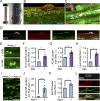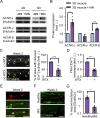A 3D culture model of innervated human skeletal muscle enables studies of the adult neuromuscular junction
- PMID: 31084710
- PMCID: PMC6516829
- DOI: 10.7554/eLife.44530
A 3D culture model of innervated human skeletal muscle enables studies of the adult neuromuscular junction
Abstract
Two-dimensional (2D) human skeletal muscle fiber cultures are ill-equipped to support the contractile properties of maturing muscle fibers. This limits their application to the study of adult human neuromuscular junction (NMJ) development, a process requiring maturation of muscle fibers in the presence of motor neuron endplates. Here we describe a three-dimensional (3D) co-culture method whereby human muscle progenitors mixed with human pluripotent stem cell-derived motor neurons self-organize to form functional NMJ connections. Functional connectivity between motor neuron endplates and muscle fibers is confirmed with calcium imaging and electrophysiological recordings. Notably, we only observed epsilon acetylcholine receptor subunit protein upregulation and activity in 3D co-cultures. Further, 3D co-culture treatments with myasthenia gravis patient sera shows the ease of studying human disease with the system. Hence, this work offers a simple method to model and evaluate adult human NMJ de novo development or disease in culture.
Keywords: 3D co-culture; acetylcholine receptor subunit epsilon; developmental biology; human; motor neuron; myasthenia gravis; neuromuscular junction; regenerative medicine; skeletal muscle; stem cells.
© 2019, Afshar Bakooshli et al.
Conflict of interest statement
MA, EL, BM, NI, CN, KT, BS, Hv, TF, MS, AB, EP, HA, HG, MZ, RA, PG No competing interests declared
Figures












References
-
- Abicht A, Dusl M, Gallenmüller C, Guergueltcheva V, Schara U, Della Marina A, Wibbeler E, Almaras S, Mihaylova V, von der Hagen M, Huebner A, Chaouch A, Müller JS, Lochmüller H. Congenital myasthenic syndromes: achievements and limitations of phenotype-guided gene-after-gene sequencing in diagnostic practice: a study of 680 patients. Human Mutation. 2012;33:1474–1484. doi: 10.1002/humu.22130. - DOI - PubMed
-
- Ashton R, Lippmann E, Estevez-Silva M, Ashton R. Chemically defined differentiation of human pluripotent stem cells to hindbrain and spinal cord neural stem cells with defined regional identities. Protocol Exchange. 2015 doi: 10.1038/protex.2015.076. - DOI
Publication types
MeSH terms
Grants and funding
- Ontario Graduate Scholarship/University of Toronto/International
- OMNI-2017-01/Ontario Institute for Regenerative Medicine/International
- 31390/Canada Foundation for Innovation/International
- Foundation Scheme 15427/CIHR/Canada
- R21NS082618/NH/NIH HHS/United States
- Innovation in Regulatory Science Award/Burroughs Wellcome Fund/International
- CREATE TOeP/Natural Sciences and Engineering Research Council of Canada/International
- RGPIN-2017-06738/Natural Sciences and Engineering Research Council of Canada/International
- R21 NS082618/NS/NINDS NIH HHS/United States
- Network of Genetic Biobanks (GTB12001D)/AFM-Téléthon/International
- Myobank/AFM-Téléthon/International
- STAR center grant 83573701/U.S. Environmental Protection Agency/International
- 950-231201/Canada Research Chairs/International
- 'Medicine by Design' OMNI-2017-01/Canada First Research Excellence Fund/International
- 31390/Ontario Research Fund/International
- Deans Fund/University of Toronto Faculty of Medicine/International
- RGPIN 435724-13/Natural Sciences and Engineering Research Council of Canada/International
- 1F32NS083291-01A1/NH/NIH HHS/United States
- R33 NS082618/NS/NINDS NIH HHS/United States
LinkOut - more resources
Full Text Sources
Other Literature Sources
Research Materials

